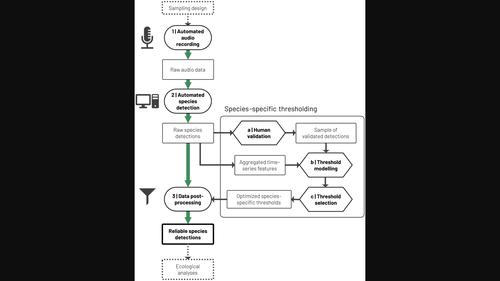Aggregated time-series features boost species-specific differentiation of true and false positives in passive acoustic monitoring of bird assemblages
IF 4.3
2区 环境科学与生态学
Q1 ECOLOGY
引用次数: 0
Abstract
Passive acoustic monitoring (PAM) has gained increasing popularity to study behaviour, habitat preferences, distribution and community assembly of birds and other animals. Automated species classification algorithms like ‘BirdNET’ are capable of detecting and classifying avian vocalizations within extensive audio data, covering entire species assemblages. PAM reveals substantial potential for biodiversity monitoring that informs evidence-based conservation. Nevertheless, fully realizing this potential remains challenging, especially due to the issue of false-positive species detections. Here, we introduce an optimized thresholding framework, which incorporates contextual information extracted from the time-series of automated species detections (i.e. covariates on quality and quantity of species' detections measured at varying time intervals) to improve the differentiation of true and false positives. We verified a sample of BirdNET detections per species and modelled species-specific thresholds using conditional inference trees. These thresholds were designed to minimize false-positive detections while maximizing the preservation of true positives in the dataset. We tested this framework for a large dataset of BirdNET detections (5760 h of audio data, 60 sites) recorded over an entire breeding season. Our results revealed considerable interspecific variability of precision (percentage of true positives) within raw BirdNET data. Our optimized thresholding approach achieved high precision (≥0.9) for 70% of the 61 detected species, while species-specific thresholds solely relying on the BirdNET confidence scores achieved high precision for only 31% of the species. Conservative universal thresholds (not species-specific) reached high precision for 48% of the species. Our thresholding approach outperformed previous thresholding approaches and enhanced interspecific comparability for bird community analyses. By incorporating contextual information from the time-series of species detections, the differentiation of true and false positives was substantially improved. Our approach may enhance a straightforward application of PAM in biodiversity research, landscape planning and evidence-based conservation.

在鸟类群落的被动声学监测中,汇总的时间序列特征有助于按物种区分真假阳性结果
被动声学监测(PAM)在研究鸟类和其他动物的行为、栖息地偏好、分布和群落组合方面越来越受欢迎。像 "BirdNET "这样的自动物种分类算法能够在广泛的音频数据中检测鸟类的发声并进行分类,涵盖整个物种群。PAM 显示了生物多样性监测的巨大潜力,可为循证保护提供信息。然而,充分发挥这一潜力仍具有挑战性,特别是由于假阳性物种检测的问题。在此,我们引入了一个优化的阈值框架,该框架结合了从自动物种检测时间序列中提取的上下文信息(即在不同时间间隔测量的物种检测质量和数量的协变量),以改进真假阳性的区分。我们对每个物种的 BirdNET 检测样本进行了验证,并使用条件推理树模拟了特定物种的阈值。这些阈值旨在最大限度地减少假阳性检测,同时最大限度地保留数据集中的真阳性。我们对整个繁殖季节记录的大型 BirdNET 检测数据集(5760 小时音频数据,60 个站点)进行了测试。我们的结果表明,在原始 BirdNET 数据中,精度(真阳性百分比)的种间差异相当大。我们的优化阈值法对 61 个检测到的物种中的 70% 实现了高精度(≥0.9),而仅依靠 BirdNET 置信度分数的物种特定阈值仅对 31% 的物种实现了高精度。保守的通用阈值(非特定物种)对 48% 的物种达到了高精度。我们的阈值法优于以往的阈值法,增强了鸟类群落分析的种间可比性。通过从物种检测的时间序列中纳入背景信息,大大提高了真假阳性的区分度。我们的方法可以提高 PAM 在生物多样性研究、景观规划和循证保护中的直接应用。
本文章由计算机程序翻译,如有差异,请以英文原文为准。
求助全文
约1分钟内获得全文
求助全文
来源期刊

Remote Sensing in Ecology and Conservation
Earth and Planetary Sciences-Computers in Earth Sciences
CiteScore
9.80
自引率
5.50%
发文量
69
审稿时长
18 weeks
期刊介绍:
emote Sensing in Ecology and Conservation provides a forum for rapid, peer-reviewed publication of novel, multidisciplinary research at the interface between remote sensing science and ecology and conservation. The journal prioritizes findings that advance the scientific basis of ecology and conservation, promoting the development of remote-sensing based methods relevant to the management of land use and biological systems at all levels, from populations and species to ecosystems and biomes. The journal defines remote sensing in its broadest sense, including data acquisition by hand-held and fixed ground-based sensors, such as camera traps and acoustic recorders, and sensors on airplanes and satellites. The intended journal’s audience includes ecologists, conservation scientists, policy makers, managers of terrestrial and aquatic systems, remote sensing scientists, and students.
Remote Sensing in Ecology and Conservation is a fully open access journal from Wiley and the Zoological Society of London. Remote sensing has enormous potential as to provide information on the state of, and pressures on, biological diversity and ecosystem services, at multiple spatial and temporal scales. This new publication provides a forum for multidisciplinary research in remote sensing science, ecological research and conservation science.
 求助内容:
求助内容: 应助结果提醒方式:
应助结果提醒方式:


